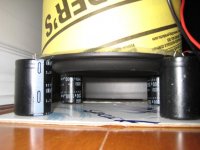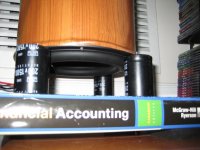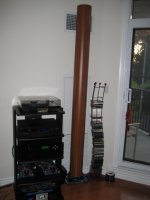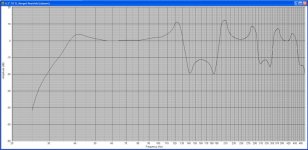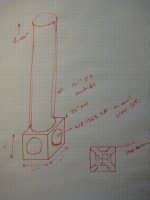el pipe subwoofers
I have a question regarding the pipe subwoofers which Mr pass has written an article about here.
www.passdiy.com/pdf/el-pipe-o.pdf
Since I had an 8 inch car woofer lying about i thought about trying to find a pipe. Now my questions are what length should the pipe be? i dont know what kind of woofer it is I have so do measurements matter MUCH or is it just a case of find ing a long pipe to fit on top and then filling it with a blanket?
And how low would it go?
And how do you go about fixing the pipe to the woofer?
thanks..
I have a question regarding the pipe subwoofers which Mr pass has written an article about here.
www.passdiy.com/pdf/el-pipe-o.pdf
Since I had an 8 inch car woofer lying about i thought about trying to find a pipe. Now my questions are what length should the pipe be? i dont know what kind of woofer it is I have so do measurements matter MUCH or is it just a case of find ing a long pipe to fit on top and then filling it with a blanket?
And how low would it go?
And how do you go about fixing the pipe to the woofer?
thanks..
For a straight pipe, the length should be a 1/4 wavelength of the Fs of the driver (or a bit shorter) and the CSA is determined by the Vas & Qts (essentially -- you'll need some other numbers to do the math or look it up in the MJK tables)
dave
dave
But I don't see how I can achieve 20hz given that the ceiling height in my room is 8 feet which means a tube length of say upto 7 feet, which equates to a resonance at 1100/28 which is approximately 40hz.
So is there any way around this without using a 14 foot long tube?
So is there any way around this without using a 14 foot long tube?
I think fixing the pipe to the woofer is covered in the article.
What I don't recall from the article (or subsequent discussion here on this very forum) was whether anyone had tried laying the pipe on its side.
What I don't recall from the article (or subsequent discussion here on this very forum) was whether anyone had tried laying the pipe on its side.
I have built the el-pipo to approximately 13 foot length and have it lying on it's side. I built it using sono-tube and a 12" car subwoofer I had laying around. I am powering it from an old plate subwoofer amp I had laying around. It really sounds good!
I get usable output to 18Hz. I think the resonant frequency for my tube is about 25-27hz. I have the amplifier low-passed at 35 hz. It really adds a nice presence to music, and when desired can really pump out some clean loud low bass.
Mini El-pipo
Hi Guys,
I've been looking for a place to post this project, so I figured this thread would work.
I designed and built a miniature version of the El-pipo using a 6.5" Tangband W6-1139SL, which you can get on sale at Parts Express for $29 right now. It's a long throw driver with a neodymium magnet and a huge rubber surround.
The pipe was designed using MJK's worksheets, and then measured using Speaker Workshop to verify that things were as expected.
MJK's worksheets gave me the following criteria based on the driver's parameters and a chosen tuning frequency of 40Hz.
Dz = 38.858
Dr = 0.095
Sl/So (taper) = 1
Cross-sectional area = 22.22" square
Length = 82.4"
Since the driver diameter was only about 6.75", I used a 6.5" section of Sonotube for the pipe. This yields a cross sectional area of 33.2" square, but it's easy to reduce the pipe's area later if need be.
The pipes are available in 8 ft lengths, so I purchased one and cut it down with an Exacto knife to the correct length of 82.5". The pipe fit perfectly in the recess of the back of the woofer's frame, so I used some industrial strength hot melt glue to attache the driver to the pipe and create an airtight seal. It's remarkably stong, and there aren't really any other options since the pipe is smaller than the outer diameter of the woofer, making a wooden fitting ring impossible.
The woofer is mounted with the cone facing out, and four small feet (capacitors) are attached to space the driver about 2" from the floor. I have attached a few pictures to show the details.
I drilled two small holes in the side of the pipe and fitted binding posts before gluing the driver in place. This allows for easy connection to an external amplifier.
So how does it work? I'd say remarkably well. I have attached a few measurement made outside in a large parking lot, and as you can see it's flat down to about 37Hz, and in room response should be even better than that. There is no stuffing in the pipe, which explains the peak at 40Hz and the peaks/valleys at and above 120Hz. Since I'm using a 4th order lowpass at 80Hz, the response ends up extending to about 125Hz and then dropping off. I later wired up a dual op-amp to add a bandstop filter between 140Hz and 250Hz, which eliminates the second peak and leaves the next closest peak down by about 40dB
Adding stuffing to the pipe would drastically reduce the peaks and valleys, and enough stuffing would almost completely eliminate them. I experimented with this, but found that adding stuffing drastically reduced the output, and didn't provide that much audible benefit once the low pass crossover was in place. It seems a little strange, but it works.
So how about the downsides? Well, there aren't really any except that most people probably don't like the look of a 7 ft tall pipe in the living room. I covered mine in a wood finish, which makes it look a little more acceptable, but certainly not invisible. I guess you could say it makes a good conversation piece.
Cheers,
Owen
Hi Guys,
I've been looking for a place to post this project, so I figured this thread would work.
I designed and built a miniature version of the El-pipo using a 6.5" Tangband W6-1139SL, which you can get on sale at Parts Express for $29 right now. It's a long throw driver with a neodymium magnet and a huge rubber surround.
The pipe was designed using MJK's worksheets, and then measured using Speaker Workshop to verify that things were as expected.
MJK's worksheets gave me the following criteria based on the driver's parameters and a chosen tuning frequency of 40Hz.
Dz = 38.858
Dr = 0.095
Sl/So (taper) = 1
Cross-sectional area = 22.22" square
Length = 82.4"
Since the driver diameter was only about 6.75", I used a 6.5" section of Sonotube for the pipe. This yields a cross sectional area of 33.2" square, but it's easy to reduce the pipe's area later if need be.
The pipes are available in 8 ft lengths, so I purchased one and cut it down with an Exacto knife to the correct length of 82.5". The pipe fit perfectly in the recess of the back of the woofer's frame, so I used some industrial strength hot melt glue to attache the driver to the pipe and create an airtight seal. It's remarkably stong, and there aren't really any other options since the pipe is smaller than the outer diameter of the woofer, making a wooden fitting ring impossible.
The woofer is mounted with the cone facing out, and four small feet (capacitors) are attached to space the driver about 2" from the floor. I have attached a few pictures to show the details.
I drilled two small holes in the side of the pipe and fitted binding posts before gluing the driver in place. This allows for easy connection to an external amplifier.
So how does it work? I'd say remarkably well. I have attached a few measurement made outside in a large parking lot, and as you can see it's flat down to about 37Hz, and in room response should be even better than that. There is no stuffing in the pipe, which explains the peak at 40Hz and the peaks/valleys at and above 120Hz. Since I'm using a 4th order lowpass at 80Hz, the response ends up extending to about 125Hz and then dropping off. I later wired up a dual op-amp to add a bandstop filter between 140Hz and 250Hz, which eliminates the second peak and leaves the next closest peak down by about 40dB
Adding stuffing to the pipe would drastically reduce the peaks and valleys, and enough stuffing would almost completely eliminate them. I experimented with this, but found that adding stuffing drastically reduced the output, and didn't provide that much audible benefit once the low pass crossover was in place. It seems a little strange, but it works.
So how about the downsides? Well, there aren't really any except that most people probably don't like the look of a 7 ft tall pipe in the living room. I covered mine in a wood finish, which makes it look a little more acceptable, but certainly not invisible. I guess you could say it makes a good conversation piece.
Cheers,
Owen
Attachments
And finally the response curves. These were measured in a huge parking lot, with one measurement taken nearfield at the woofer, and another taken nearfield at the TL exit. They were combined in Speaker Workshop. Note how this response looks exactly like the predicted response from MJK's worksheet.
Attachments
Final notes
As a little conclusion, here are a few things that could be done to improve things:
1. Glue an 79" long 3" diameter ABS pipe to the rear magnet of the driver, so that it takes away a little bit of volume from the pipe. Seal it well to the magnet of the driver, and brace it at the top or opening of the pipe.
2. Add some light stuffing to the pipe to damp out the bumps and valleys.
3. Cover the inside of the pipe with some sort of damping material. I'm not sure it would do much, but I'd feel better if the pipe didn't make a hollow sound when I tapped it.
4. Make a proper base, and don't ruin one of your wife's old textbooks. She'll already be angry about the 7ft tube, the book destruction doesn't help.
If you really wanted to do this properly, I'd buy 4 of the 8" version (W8-1363SB) and mount them on each side of an 11" by 11" MDF cube. Wire them in series/parallel to maintain constant impedance, and brace the rear magnets the to magnet of the driver directly behind it. Put a terminal cup or amp on the bottom, and put a 104" long 10" diameter pipe on the top.
This would result in an effective 30Hz tuning frequency, and you'd benefit from reduced distortion thanks to the mechanical coupling of the drivers, and the multiple drive units. This would give you very good response down to 20Hz in room, and you could play it absurdly loud with 4 drivers. It would be tiny compared to a real El-Pipo, but would likely sound better at the expense of low end extension, which the real El-Pipo has in spades.
I'd build one, but I live in a condo, and I doubt the neighbors approve of the little one I have now!
Cheers,
Owen
As a little conclusion, here are a few things that could be done to improve things:
1. Glue an 79" long 3" diameter ABS pipe to the rear magnet of the driver, so that it takes away a little bit of volume from the pipe. Seal it well to the magnet of the driver, and brace it at the top or opening of the pipe.
2. Add some light stuffing to the pipe to damp out the bumps and valleys.
3. Cover the inside of the pipe with some sort of damping material. I'm not sure it would do much, but I'd feel better if the pipe didn't make a hollow sound when I tapped it.
4. Make a proper base, and don't ruin one of your wife's old textbooks. She'll already be angry about the 7ft tube, the book destruction doesn't help.
If you really wanted to do this properly, I'd buy 4 of the 8" version (W8-1363SB) and mount them on each side of an 11" by 11" MDF cube. Wire them in series/parallel to maintain constant impedance, and brace the rear magnets the to magnet of the driver directly behind it. Put a terminal cup or amp on the bottom, and put a 104" long 10" diameter pipe on the top.
This would result in an effective 30Hz tuning frequency, and you'd benefit from reduced distortion thanks to the mechanical coupling of the drivers, and the multiple drive units. This would give you very good response down to 20Hz in room, and you could play it absurdly loud with 4 drivers. It would be tiny compared to a real El-Pipo, but would likely sound better at the expense of low end extension, which the real El-Pipo has in spades.
I'd build one, but I live in a condo, and I doubt the neighbors approve of the little one I have now!
Cheers,
Owen
Attachments
opc said:And finally the response curves. These were measured in a huge parking lot, with one measurement taken nearfield at the woofer, and another taken nearfield at the TL exit. They were combined in Speaker Workshop. Note how this response looks exactly like the predicted response from MJK's worksheet.
OPC, which measurement system did you use? Would you recommend it? I'm getting started building speakers and looking for a good speaker measurement system.
I'm building an H-frame with a Goldwood GW-1858 woofer mated to an OB with a pair of MOTH's Nelson donated to my DIY cause. Planning on using active crossovers for this project.
Thanks,
-David
Hi David,
Those measurements were taken using Speaker Workshop which is free measurement software from Audua. You can download it here:
http://www.speakerworkshop.com/
It's rather difficult to setup initially, and you have to make several simple wire jigs, but if you're just getting started then it's a great way to get your feet wet without spending $400 on Sound Easy or several thousand dollars on some of the other options.
There are several excellent tutorials with step by step guides. My favorite is here:
http://www.claudionegro.com/
The only other hardware you need is a microphone (Behringer ECM-8000) and a sound card.
I suggest you install it on a laptop, and find a good USB sound card. I use an M-Audio Fast Track Pro. Having easy portability means you can measure anywhere, which is great for parking lot trips!
Let me know if you have any other questions.
Cheers,
Owen
Those measurements were taken using Speaker Workshop which is free measurement software from Audua. You can download it here:
http://www.speakerworkshop.com/
It's rather difficult to setup initially, and you have to make several simple wire jigs, but if you're just getting started then it's a great way to get your feet wet without spending $400 on Sound Easy or several thousand dollars on some of the other options.
There are several excellent tutorials with step by step guides. My favorite is here:
http://www.claudionegro.com/
The only other hardware you need is a microphone (Behringer ECM-8000) and a sound card.
I suggest you install it on a laptop, and find a good USB sound card. I use an M-Audio Fast Track Pro. Having easy portability means you can measure anywhere, which is great for parking lot trips!
Let me know if you have any other questions.
Cheers,
Owen
- Status
- Not open for further replies.
- Home
- Amplifiers
- Pass Labs
- El Pipe-O subwoofers
